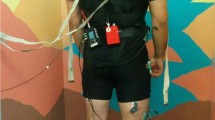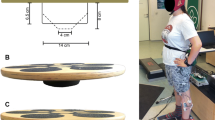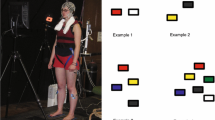Abstract
The goal of this study was to identify whether impaired cortical preparation may relate to impaired scaling of postural responses of people with Parkinson’s disease (PD). We hypothesized that impaired scaling of postural responses in participants with PD would be associated with impaired set-dependent cortical activity in preparation for perturbations of predictable magnitudes. Participants performed postural responses to backward surface translations. We examined the effects of perturbation magnitude (predictable small vs. predictable large) and predictability of magnitude (predictable vs. unpredictable-in-magnitude) on postural responses (center-of-pressure (CoP) displacements) and on preparatory electroencephalographic (EEG) measures of contingent negative variation (CNV) and alpha and beta event-related desynchronization (ERD). Our results showed that unpredictability of perturbation magnitude, but not the magnitude of the perturbation itself, was associated with increased CNV amplitude at the CZ electrode in both groups. While control participants scaled their postural responses to the predicted magnitude of the perturbation, their condition-related changes in CoP displacements were not correlated with condition-related changes in EEG preparatory activity (CNV or ERD). In contrast, participants with PD did not scale their postural responses to the predicted magnitude of the perturbation, but they did demonstrate greater beta ERD in the condition of predictably small-magnitude perturbations and greater beta ERD than the control participants at the CZ electrode. In addition, increased beta ERD in PD was associated with decreased adaptability of postural responses, suggesting that preparatory cortical activity may have a more direct influence on postural response scaling for people with PD than for control participants.









Similar content being viewed by others
References
Adkin AL, Quant S, Maki BE, McIlroy WE (2006) Cortical responses associated with predictable and unpredictable compensatory balance reactions. Exp Brain Res 172:85–93
Adkin AL, Campbell AD, Chua R, Carpenter MG (2008) The influence of postural threat on the cortical response to unpredictable and predictable postural perturbations. Neurosci Lett 435:120–125
Aotsuka A, Weate SJ, Drake ME Jr, Paulson GW (1996) Event-related potentials in Parkinson’s disease. Electromyogr Clin Neurophysiol 36:215–220
Babiloni C, Carducci F, Cincotti F, Rossini PM, Neuper C, Pfurtscheller G, Babiloni F (1999) Human movement-related potentials vs desynchronization of EEG alpha rhythm: a high-resolution EEG study. NeuroImage 10:658–665
Badke MB, Duncan PW, Di Fabio RP (1987) Influence of prior knowledge on automatic and voluntary postural adjustments in healthy and hemiplegic subjects. Phys Ther 67:1495–1500
Bares M, Nestrasil I, Rektor I (2007) The effect of response type (motor output versus mental counting) on the intracerebral distribution of the slow cortical potentials in an externally cued (CNV) paradigm. Brain Res Bull 71:428–435
Beckley DJ, Bloem BR, Remler MP, Roos RA, Van Dijk JG (1991) Long latency postural responses are functionally modified by cognitive set. Electroencephalogr Clin Neurophysiol 81:353–358
Beckley DJ, Bloem BR, Remler MP (1993) Impaired scaling of long latency postural reflexes in patients with Parkinson’s disease. Electroencephalogr Clin Neurophysiol 89:22–28
Bender S, Resch F, Weisbrod M, Oelkers-Ax R (2004) Specific task anticipation versus unspecific orienting reaction during early contingent negative variation. Clin Neurophysiol 115:1836–1845
Bloem BR, van Vugt JP, Beckley DJ (2001) Postural instability and falls in Parkinson’s disease. Adv Neurol 87:209–223
Chong RK, Jones CL, Horak FB (1999) Postural set for balance control is normal in Alzheimer’s but not in Parkinson’s disease. J Gerontol A Biol Sci Med Sci 54:M129–M135
Chong RK, Horak FB, Woollacott MH (2000) Parkinson’s disease impairs the ability to change set quickly. J Neurol Sci 175:57–70
Crone NE, Miglioretti DL, Gordon B, Sieracki JM, Wilson MT, Uematsu S, Lesser RP (1998) Functional mapping of human sensorimotor cortex with electrocorticographic spectral analysis. I. Alpha and beta event-related desynchronization. Brain 12:2271–2299
Del Percio C, Brancucci A, Bergami F, Marzano N, Fiore A, Di Ciolo E, Aschieri P, Lino A, Vecchio F, Iacoboni M, Gallamini M, Babiloni C, Eusebi F (2007) Cortical alpha rhythms are correlated with body sway during quiet open-eyes standing in athletes: a high-resolution EEG study. NeuroImage 36:822–829
Delorme A, Makeig S (2004) EEGLAB: an open source toolbox for analysis of single-trial EEG dynamics including independent component analysis. J Neurosci Methods 134:9–21
Dietz V, Quintern J, Berger W, Schenck E (1985) Cerebral potentials and leg muscle e.m.g. responses associated with stance perturbation. Exp Brain Res 57:348–354
Duckrow RB, Abu-Hasaballah K, Whipple R, Wolfson L (1999) Stance perturbation-evoked potentials in old people with poor gait and balance. Clin Neurophysiol 110:2026–2032
Filipovic SR, Jahanshahi M, Rothwell JC (2001) Uncoupling of contingent negative variation and alpha band event-related desynchronization in a go/no-go task. Clin Neurophysiol 112:1307–1315
Fischer T, Langner R, Diers K, Brocke B, Birbaumer N (2010) Temporo-spatial dynamics of event-related EEG beta activity during the initial contingent negative variation. PLoS ONE 5:e12514
Fogelson N, Williams D, Tijssen M, van Bruggen G, Speelman H, Brown P (2006) Different functional loops between cerebral cortex and the subthalmic area in Parkinson’s disease. Cereb Cortex 16:64–75
Fujiwara K, Kiyota N, Maeda K (2011) Contingent negative variation and activation of postural preparation before postural perturbation by backward floor translation at different initial standing positions. Neurosci Lett 490:135–139
Grillner S, Hellgren J, Menard A, Saitoh K, Wikstrom MA (2005) Mechanisms for selection of basic motor programs–roles for the striatum and pallidum. Trends Neurosci 28:364–370
Hamano T, Luders HO, Ikeda A, Collura TF, Comair YG, Shibasaki H (1997) The cortical generators of the contingent negative variation in humans: a study with subdural electrodes. Electroencephalogr Clin Neurophysiol 104:257–268
Hanakawa T, Fukuyama H, Katsumi Y, Honda M, Shibasaki H (1999) Enhanced lateral premotor activity during paradoxical gait in Parkinson’s disease. Ann Neurol 45:329–336
Henry SM, Fung J, Horak FB (1998) Control of stance during lateral and anterior/posterior surface translations. IEEE Trans Rehabil Eng 6:32–42
Horak FB, Diener HC (1994) Cerebellar control of postural scaling and central set in stance. J Neurophysiol 72:479–493
Horak FB, MacPherson JM (1996) Postural orientation and equilibrium. In: Rowell LB, Sheperd JT (eds) Handbook of physiology. Oxford University Press, Oxford, pp 255–288
Horak FB, Diener HC, Nashner LM (1989) Influence of central set on human postural responses. J Neurophysiol 62:841–853
Horak FB, Frank J, Nutt J (1996) Effects of dopamine on postural control in parkinsonian subjects: scaling, set, and tone. J Neurophysiol 75:2380–2396
Ikeda A, Shibasaki H, Kaji R, Terada K, Nagamine T, Honda M, Kimura J (1997) Dissociation between contingent negative variation (CNV) and Bereitschaftspotential (BP) in patients with parkinsonism. Electroencephalogr Clin Neurophysiol 102:142–151
Jacobs JV, Horak FB (2006) Abnormal proprioceptive-motor integration contributes to hypometric postural responses of subjects with Parkinson’s disease. Neuroscience 141:999–1009
Jacobs JV, Horak FB (2007) Cortical control of postural responses. J Neural Transm 114:1339–1348
Jacobs JV, Fujiwara K, Tomita H, Furune N, Kunita K, Horak FB (2008) Changes in the activity of the cerebral cortex relate to postural response modification when warned of a perturbation. Clin Neurophysiol 119:1431–1442
Jacobs JV, Henry SM, Nagle KJ (2010) Low back pain associates with altered activity of the cerebral cortex prior to arm movements that require postural adjustment. Clin Neurophysiol 121:431–440
Klostermann F, Nikulin VV, Kuhn AA, Marzinzik F, Wahl M, Pogosyan A, Kupsch A, Schneider GH, Brown P, Curio G (2007) Task-related differential dynamics of EEG alpha- and beta-band synchronization in cortico-basal motor structures. Eur J Neurosci 25:1604–1615
Lamarche M, Louvel J, Buser P, Rektor I (1995) Intracerebral recordings of slow potentials in a contingent negative variation paradigm: an exploration in epileptic patients. Electroencephalogr Clin Neurophysiol 95:268–276
Maki BE, Whitelaw RS (1993) Influence of expectation and arousal on center-of-pressure responses to transient postural perturbations. J Vestib Res 3:25–39
Mochizuki G, Sibley KM, Esposito JG, Camilleri JM, McIlroy WE (2008) Cortical responses associated with the preparation and reaction to full-body perturbations to upright stability. Clinical Neurophys 119:1626–1637
Mochizuki G, Boe S, Marlin A, McIlRoy WE (2010) Perturbation-evoked cortical activity reflects both the context and consequence of postural instability. Neuroscience 170:599–609
Morris ME, Iansek R, Matyas TA, Summers JJ (1996) Stride length regulation in Parkinson’s disease. Normalization strategies and underlying mechanisms. Brain 119:551–568
Morris ME, Martin CL, Schenkman ML (2009) Striding out with Parkinson disease: evidence-based physical therapy for gait disorders. Phys Ther 90:280–288
Nasreddine ZS, Phillips NA, Bedirian V, Charbonneau S, Whitehead V, Collin I, Cummings JL, Chertkow H (2005) The Montreal cognitive assessment, MoCA: a brief screening tool for mild cognitive impairment. J Am Geriatr Soc 53:695–699
Oishi M, Mochizuki Y, Du C, Takasu T (1995) Contingent negative variation and movement-related cortical potentials in parkinsonism. Electroencephalogr Clin Neurophysiol 95:346–349
Pfurtscheller G (1977) Graphical display and statistical evaluation of event-related desynchronization (ERD). Electroencephalogr Clin Neurophysiol 43:757–760
Pfurtscheller G (1992) Event-related synchronization (ERS): an electrophysiological correlate of cortical areas at rest. Electroencephalogr Clin Neurophysiol 83:62–69
Pfurtscheller G (2000) Spatiotemporal ERD/ERS patterns during voluntary movement and motor imagery. Suppl Clin Neurophysiol 53:196–198
Pfurtscheller G, Aranibar A (1977) Event-related cortical desynchronization detected by power measurements of scalp EEG. Electroencephalogr Clin Neurophysiol 42:817–826
Pfurtscheller G, Lopes da Silva FH (1999) Event-related EEG/MEG synchronization and desynchronization: basic principles. Clin Neurophysiol 110:1842–1857
Pfurtscheller G, Neuper C, Krausz G (2000) Functional dissociation of lower and upper frequency mu rhythms in relation to voluntary limb movement. Clin Neurophysiol 111:1873–1879
Pirini M, Mancini M, Farella E, Chiari L (2011) EEG correlates of postural audio-biofeedback. Hum Mov Sci 30:249–261
Praamstra P, Meyer AS, Cools AR, Horstink MW, Stegeman DF (1996) Movement preparation in Parkinson’s disease. Time course and distribution of movement-related potentials in a movement precueing task. Brain 119:1689–1704
Prochazka A (1989) Sensorimotor gain control: a basic strategy of motor systems? Prog Neurobiol 33:281–307
Pulvermuller F, Lutzenberger W, Muller V, Mohr B, Dichgans J, Birbaumer N (1996) P3 and contingent negative variation in Parkinson’s disease. Electroencephalogr Clin Neurophysiol 98:456–467
Slobounov S, Hallett M, Stanhope S, Shibasaki H (2005) Role of cerebral cortex in human postural control: an EEG study. Clin Neurophysiol 116:315–323
Tzagarakis C, Ince NF, Leuthold AC, Pellizzer G (2010) Beta-band activity during motor planning reflects response uncertainty. J Neurosci 30:11270–11277
van Boxtel GJ, Brunia CH (1994a) Motor and non-motor aspects of slow brain potentials. Biol Psychol 38:37–51
van Boxtel GJ, Brunia CH (1994b) Motor and non-motor components of the contingent negative variation. Int J Psychophysiol 17:269–279
Walter WG, Cooper R, Aldridge VJ, McCallum WC, Winter AL (1964) Contingent negative variation: an electric sign of sensorimotor association and expectancy in the human brain. Nature 203:380–384
Wheaton LA, Carpenter M, Mizelle JC, Forrester L (2008) Preparatory band specific premotor cortical activity differentiates upper and lower extremity movement. Exp Brain Res 184:121–126
Acknowledgments
We would like to thank our participants. We would like to thank Kristin Lucas, PT, DPT, for her invaluable assistance with data collections. We would like to acknowledge our funding sources: National Institutes of Health, National Institute of Aging R37 A60006457 (FBH), National Institutes of Health, National Institute of Child Health and Human Development F32 HD070796 (BAS), Medical Research Foundation of Oregon (BAS), the Foundation for Physical Therapy (BAS) and National Institutes of Health, National Institute of Aging T32AG023477. Funding sources provided funding only and did not influence the work. Abstracts of this work were presented at the Society for Neuroscience Annual Conferences in 2010 (San Diego, CA) and 2011 (Washington, DC), the Oregon Physical Therapy Association Annual Conference (Portland, OR, April 2011) and the Pacific Northwest Basal Ganglia Coterie (Hood River, OR, May 2011).
Conflict of interest
The authors declare that they have no conflict of interest.
Author information
Authors and Affiliations
Corresponding author
Rights and permissions
About this article
Cite this article
Smith, B.A., Jacobs, J.V. & Horak, F.B. Effects of magnitude and magnitude predictability of postural perturbations on preparatory cortical activity in older adults with and without Parkinson’s disease. Exp Brain Res 222, 455–470 (2012). https://doi.org/10.1007/s00221-012-3232-3
Received:
Accepted:
Published:
Issue Date:
DOI: https://doi.org/10.1007/s00221-012-3232-3




